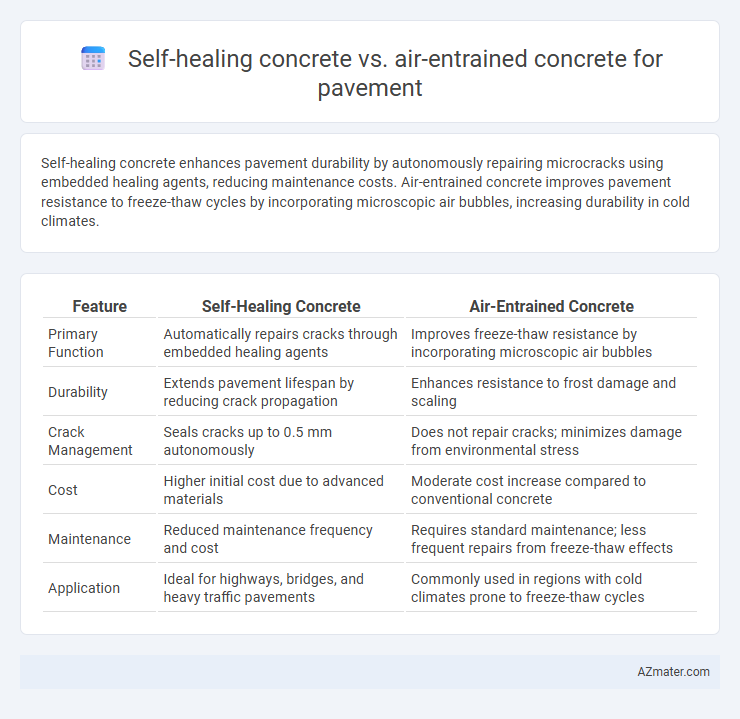Self-healing concrete enhances pavement durability by autonomously repairing microcracks using embedded healing agents, reducing maintenance costs. Air-entrained concrete improves pavement resistance to freeze-thaw cycles by incorporating microscopic air bubbles, increasing durability in cold climates.
Table of Comparison
| Feature | Self-Healing Concrete | Air-Entrained Concrete |
|---|---|---|
| Primary Function | Automatically repairs cracks through embedded healing agents | Improves freeze-thaw resistance by incorporating microscopic air bubbles |
| Durability | Extends pavement lifespan by reducing crack propagation | Enhances resistance to frost damage and scaling |
| Crack Management | Seals cracks up to 0.5 mm autonomously | Does not repair cracks; minimizes damage from environmental stress |
| Cost | Higher initial cost due to advanced materials | Moderate cost increase compared to conventional concrete |
| Maintenance | Reduced maintenance frequency and cost | Requires standard maintenance; less frequent repairs from freeze-thaw effects |
| Application | Ideal for highways, bridges, and heavy traffic pavements | Commonly used in regions with cold climates prone to freeze-thaw cycles |
Introduction to Advanced Concrete Technologies
Self-healing concrete incorporates microcapsules or bacteria that activate to repair cracks autonomously, extending pavement lifespan and reducing maintenance costs. Air-entrained concrete contains microscopic air bubbles that enhance freeze-thaw durability by improving resistance to cracking in cold climates. Both technologies represent advancements in concrete durability and resilience, offering innovative solutions for sustainable pavement infrastructure.
Understanding Self-Healing Concrete
Self-healing concrete incorporates microcapsules or bacteria that activate upon crack formation, promoting automatic repair and extending pavement lifespan by reducing maintenance needs. Air-entrained concrete contains microscopic air bubbles to improve freeze-thaw durability but lacks the autonomous crack repair mechanism found in self-healing variants. Understanding self-healing concrete's capabilities highlights its potential to revolutionize pavement infrastructure by mitigating crack propagation and enhancing structural resilience.
Basics of Air-Entrained Concrete
Air-entrained concrete incorporates microscopic air bubbles to enhance durability by improving resistance to freeze-thaw cycles and deicing chemicals, making it suitable for pavements in cold climates. This technique reduces surface scaling and improves workability while maintaining strength, crucial for long-lasting pavement performance. Self-healing concrete, in contrast, contains special agents that autonomously seal cracks, offering extended lifespan benefits but is typically more costly and less widely adopted than air-entrained concrete.
Mechanisms of Self-Healing in Pavements
Self-healing concrete utilizes encapsulated healing agents or mineral admixtures that activate upon crack formation, promoting autonomous crack repair and enhanced durability in pavements. Air-entrained concrete incorporates microscopic air bubbles to improve freeze-thaw resistance but lacks intrinsic crack repair capabilities. The mechanism of self-healing in pavements involves the precipitation of calcium carbonate or polymer formation that seals micro-cracks, reducing maintenance frequency and extending service life.
Air-Entrained Concrete: Properties and Benefits for Pavement
Air-entrained concrete incorporates microscopic air bubbles that enhance durability and resistance to freeze-thaw cycles, making it ideal for pavement exposed to harsh weather conditions. These air voids improve the concrete's workability and reduce water permeability, leading to fewer cracks and longer pavement lifespan. In contrast to self-healing concrete, air-entrained concrete provides proven protection against frost damage and scaling without requiring advanced chemical additives.
Comparative Durability: Self-Healing vs Air-Entrained Concrete
Self-healing concrete exhibits enhanced durability by autonomously repairing micro-cracks through embedded bacteria or polymers, significantly reducing water ingress and freeze-thaw damage compared to air-entrained concrete. Air-entrained concrete improves durability primarily by incorporating microscopic air bubbles that mitigate freeze-thaw stresses, yet it does not actively repair damage once formed. Studies reveal self-healing concrete extends pavement lifespan via crack remediation, while air-entrained concrete offers reliable resistance to frost damage but lacks self-repair capabilities.
Performance in Freeze-Thaw Cycles
Self-healing concrete enhances pavement durability in freeze-thaw cycles by autonomously repairing microcracks, reducing water infiltration, and minimizing freeze-induced damage. Air-entrained concrete improves performance by incorporating microscopic air bubbles that provide space for ice expansion, thus preventing internal cracking and scaling. Comparative studies show self-healing concrete offers prolonged service life and lower maintenance costs, while air-entrained concrete remains a cost-effective solution with proven freeze-thaw resistance.
Cost Analysis and Long-Term Maintenance
Self-healing concrete reduces long-term maintenance costs by autonomously repairing microcracks, extending pavement lifespan and minimizing expensive repairs. Air-entrained concrete, while cheaper initially due to simple production methods, can incur higher maintenance expenses from frequent freeze-thaw damage in cold climates. Cost analysis reveals that despite a higher upfront investment, self-healing concrete offers significant savings over time through decreased maintenance and enhanced durability in pavements.
Environmental Impact and Sustainability
Self-healing concrete significantly reduces maintenance frequency and material consumption in pavement infrastructure, leading to lower carbon emissions and extended service life compared to traditional air-entrained concrete. Air-entrained concrete improves freeze-thaw durability but involves higher cement content, contributing to increased CO2 emissions during production. Prioritizing self-healing concrete supports sustainable development by decreasing repair-related resource use and minimizing environmental footprint over the pavement lifecycle.
Choosing the Ideal Concrete for Pavement Applications
Self-healing concrete enhances pavement durability through microcapsules releasing healing agents that repair cracks autonomously, reducing maintenance costs and extending lifespan. Air-entrained concrete improves freeze-thaw resistance by incorporating microscopic air bubbles, preventing internal cracking and scaling in cold climates. Selecting the ideal pavement concrete depends on environmental conditions and maintenance priorities, with self-healing concrete suited for high-stress areas requiring longevity, while air-entrained concrete excels in freeze-thaw environments demanding enhanced durability.

Infographic: Self-healing concrete vs Air-entrained concrete for Pavement
 azmater.com
azmater.com